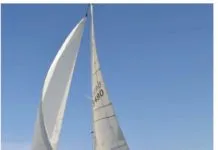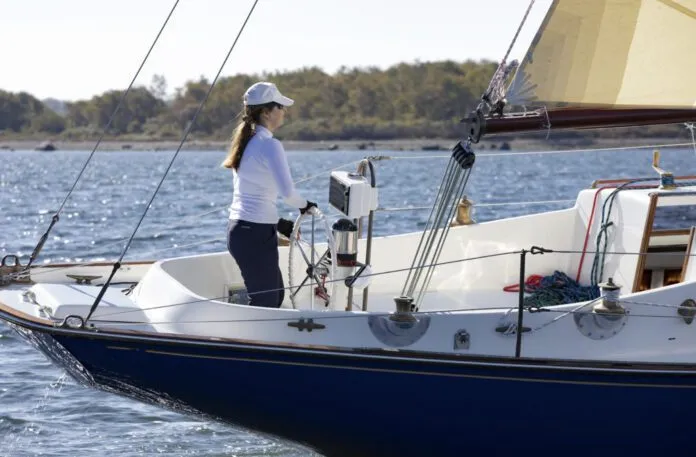Few designers ever see a set of lines catch on like those belonging to Phil Rhodes classic sloop Altair. Not only did the wooden masterpiece spawn a gaggle of sisters such as Thor of Oyster Bay, but in 1956, Rhodes son, Bodie, who was working for his father at the time, scaled Altairs lines into a slightly smaller sloop, a boat destined to become the prototype of the 40-foot fiberglass production racer-cruiser.
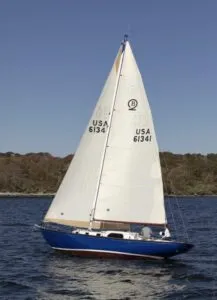
The Bounty II project was undertaken by Fred Coleman and Vince Lazzara at Aero Marine in California, using Rhodes’s design work and Bill Garden’s engineering input. With all the talent brought to bear, it’s no surprise that the vessel became an instant success. Its heavy scantlings and the building teams precautionary approach with the new material called fiberglass paid off in the long run. Their “thick as a plank” hull skin may have been overkill, but the results speak for themselves. Many of these classic plastics still easily pass survey today.
When Aero Marine closed its doors in 1960, an enterprising group of Grumman executives with a keen boating interest and a desire to diversify the company bought Aero Marine’s assets and shipped the Bounty II tooling to a New England boatbuilder in which it already held a controlling interest. Cousins Everett and Clint Pearson had entered into partnership with Grumman, and under the Pearson label, some changes were made to the Bounty II, creating a sloop that Pearson dubbed the Rhodes 41. Perhaps the best measure of the success of this effort lies in the fact that of the approximately 50 Rhodes 41s (built from 1961 to 68), not only are nearly all still around today, but a cult following has arisen that makes them one of the most sought-after oldies-but-goodies afloat.
The all-around success of these boats is perhaps best demonstrated by the accomplishments of Eric Crawford and his Chesapeake Bay-based crew. Crawford painstakingly restored his three-decades-old Pearson 41, Restless, to pristine condition. With the addition of modern hardware, cordage, and winches, plus a good suit of sails, he and his able crew have tallied an impressive string of race results on the bay.

In 2000, he took the program to sea with hopes for a respectable showing among a fleet of much newer, much more race-refined sailboats. Crawford and crew did more than hold their own. They took home the prestigious overall win in the premier of ocean races: the biannual Newport to Bermuda Race. Yes, reaching conditions prevailed, and an age allowance helped the rating, but as every Pearson 41 owner will attest, when the breeze fills in and the beat gives way to a reach, the thoroughbred in the classic Pearson 41 comes to life.
Another Chesapeake Bay local, George Dunigan, has favored a cruising tack with the restoration of his Pearson 41, Lightfoot. And as the photos in the accompanying chart show, his Rhodes restoration efforts reveal how modern coatings can help give an older boat a facelift and make her easier to maintain to boot. With an Awlgrip-coated hull, Interlux Perfection buff-colored deck, and Cetol-sealed woodwork, she’s an eye-catcher and a great example of what can be done to rejuvenate a sound but cosmetically tired sailboat.
Dunigan and his wife appreciate the good-sized aft cockpit, and the low-profile dodger/bimini combination offers protection against the searing summer sun. Lightfoot’s conversion to the cruising side included the addition of an anchor roller and windlass, furling headsail, electric refrigeration, and a 27-horsepower Westerbeke, which was shoehorned into the space once occupied by an Atomic 4.
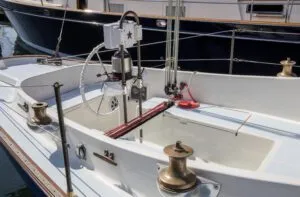
The big plus is that the vessel retains its seakeeping ability and remains very easy to handle when sailing shorthanded.
DESIGN AND CONSTRUCTION
In a marketplace currently driven by putting less material in a structure but still generating adequate strength, it’s nice to see what the alternate can deliver. The Pearson 41 features a solid fiberglass hull with encapsulated lead ballast held as tightly as an NFL fullback holds the ball when punching through the line. Hull stiffness is generated by extra units of alternating 24-ounce woven roving and 1.5-ounce mat. The high-quality polyester resin of the era and Pearson’s approach to the hand lay-up process delivered hulls with good void control and better-than-average blister resistance. In cases where blistering has occurred, the thick laminate can be easily repaired without jeopardizing strength.
Built in the era before pans and liners dominated interiors, these “stick built” accommodations were more time-consuming to build, but each bonded gusset and tabbed-in bulkhead added additional support to the hull and deck. This approach also allowed access to more of the inner surface of the vessel. However, some surveyors frown when they lift cutouts in the cabin sole and see tanks preventing inspection of much of the bilge area. The good news is that the encapsulated ballast has no keelbolts to inspect, and the tanks, at least the ones in the earlier hulls, were monel, a nearly inert metal that’s the material of choice for tanks, shafts, and heat exchangers. Unfortunately, its cost has skyrocketed and made its use all but disappear from the waterfront.
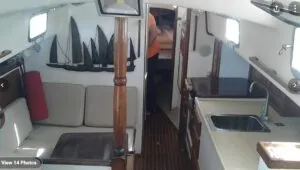
Some of the most meaningful changes made in the Pearson/Rhodes evolution were the upgrade from iron to lead ballast and the addition of more freeboard. Pearson also eliminated the bulwark found aboard the Bounty II. The Pearson 41 incorporates an inward-turning, hull-to-deck joint and a traditional, mechanically fastened teak toerail. The one rather large coachroof window, a signature of the Bounty II, was split into two smaller windows with fiberglass-reinforced plastic (FRP) reinforcement between the two, a change that improved both aesthetics and the structural integrity of the cabinhouse.
Opening ports, substantial hardware and a teak cabin sole gave the Pearson 41 a traditional feel. Both of these Rhodes-designed boats share a fine lineage, and neither should be considered deficient due to the small differences between them.
Structure and stability are a strong point in this vessel. Narrow beam and a healthy ballast/displacement ratio mean that she can recover from a deep capsize. Her thick-as-a-plank glasswork has made the boat heavier than perhaps necessary, but the resulting strength has lessened worry over fatigue cycle-loading and any flexing in the garboard region that might lead to delamination and keel failure. These ruggedly built hulls will continue to deliver owner satisfaction for years to come.
The decks are cored, and some boats have areas where delamination and water intrusion have become an issue. If these regions are small (a square foot or so), an epoxy injection repair may solve the problem. This involves localized top-down hole drilling, drying the core area, and carefully injecting epoxy into the holes. Compression with weights (sandbags work) while curing, followed by re-finishing the deck completes the repair. When larger areas are involved, you may need to cut out a portion of the deck and remove the old rotted core. Inserting new core and rebonding the top FRP skin is a time-consuming but straightforward job, a feasible DIY project for those comfortable working with epoxy products, core materials, and tabbing secondary FRP bonds. A number of fiberglass repair books document this type of repair, including the “Fiberglass Boat Repair & Maintenance” guide, available free at www.westsystem.com.
INTERIOR
These modest-freeboard, wide-sidedeck sloops have none of the bulging proportions of modern production boats with their high-volume interiors. Yes, they lack the big open space saloon, but for many, the simple layout with four usable sea berths located in the most stable part of the boat makes more sense.
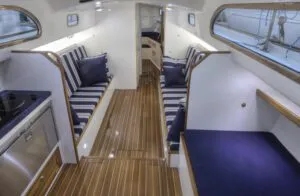
The galley is split port and starboard, with the stove on one side and the big ice box/fridge on the other. Though not ideal, this arrangement affords additional galley counter space and useful room to spread a chart while sailing.
The lack of a dedicated sit-down chart table may turn off the technophile, but with some creativity, a place can be found for all the necessary electronics. A small enclosed head, lockers, and a conventional V-berth lie forward of the keel-stepped mast.
Pearson’s rendition of the Rhodes design regarded wood-grained Formica as a new wonder material, but, like the Palmer-Johnson crew that finished off a few of the Bounty IIs, the Pearson team also understood that interior decor was significantly enhanced with well-done wood trim, fiddles, and hand rails, offsetting the effect of the faux wood grain. A step above Good Humor-white Formica, the Pearson version, like the Palmer-Johnson-built Bounty IIs, has a traditional yacht feel below.
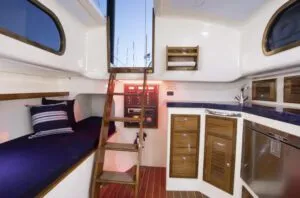
UNDER SAIL
There’s no question that this boat needs a breeze to really get going. Its long keel is thick at the foot and wide in the garboard region, adding more drag than one would find in a modern fin-keeler. Heavy displacement and substantial wetted surface make sailing in light-wind conditions less than invigorating. But at sea, the sloop has a kind motion, and lots of directional stability. This is a big plus for short-handed crews with an interest in energy-efficient self-steering. For decades sailors simply added a mechanical steering vane to the transom and an anchor winch on the foredeck and headed for the Caribbean or South Pacific. The boat remains a viable passage maker for budget-minded sailors who adore simplicity and the value of a versatile cruiser.
The Pearson 41 sports a relatively short, low-aspect-ratio rig, with a rather modest sail-area-to-displacement ratio. Consequently, every effort should be made to keep as much versatility in the sail plan as possible. One option is to set up a double-headsail (cutter) rig using a removable inner forestay and runners. Another option negates the need for runners by installing hardware to rig a Solent stay. This involves installing a 1×19 wire to a fitting near the masthead that’s far enough below the top so that the wire does not chafe against roller-furling gear. A halyard must also be set up to work in conjunction with this stay. Both a hank-on, heavy-weather jib and a storm jib can fly from this removable stay. In light air, other sail-carrying options can augment the “one-size-fits-all” roller furler. (A 150-percent furling genoa is the standard for the Chesapeake.) These include a drifter and asymmetric spinnaker that can be tacked to the end of an anchor roller that has been intentionally structured to take such loads. Such light-air sails can also be flown from a short removable deck-mounted sprit. The result is an ability to achieve decent performance in 8-10 knots of wind and save the diesel fuel for even calmer conditions.
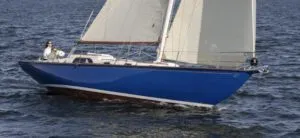
Waterline length is not the sole determiner of top-end boat speed. The Pearson 41’s short, 28-foot waterline lengthens as she heels or starts to squat with speed. With either a tiller or wheel, the attached rudder has none of the rebellious characteristics associated with many unbalanced rudders. However, those really interested in making a great boat even better may want to consider a modification made by one aerospace engineer just prior to sailing his Bounty II to a class victory in the classic Trans-Pacific Yacht Race.
The skipper designed a spade rudder that was professionally fitted in the lengthy counter aft. Its even possible to retain the attached rudder and use it as a trim-tab steering appendage. Connect a Monitor or other servo-pendulum self-steering gear to a mini tiller that steers the new spade rudder, and you’ll have a boat with enviable self-steering performance and outstanding steering control. As an added bonus, this arrangement also offers rudder redundancy. For a decade or so, many custom ocean racers were designed with both a keel-attached trim tab and separate skeg or spade rudder, a combination valued in long-distance passage making.
MECHANICAL/ELECTRICAL
There’s not much room under the companionway ladder and even the venerable Atomic 4, Pearson’s favorite auxiliary, found it a pretty tight squeeze. When it came to putting the gas engine out to pasture, the solution aboard Lightfoot involved the installation of a 27-horsepower Westerbeke, the largest block that would fit into the available configuration. Finding room for the exhaust, water strainer, fuel and oil filters, and a bigger alternator was a bit of a challenge, but a skilled local mechanic maximized the use of the available space.
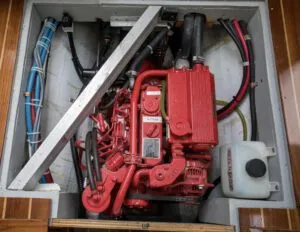
There wasn’t much worry about a suite of electronics or high-current, 12-volt DC needs in 1962, and Pearson delivered boats with a battery switch and a minimal fuse panel. Most owners rewire from scratch, if they plan to turn the boat into a modern high-current-capacity DC platform. Others resist the urge and keep systems simple and easier to maintain. Either way, this is a versatile tabula rasa interior that can be high-tech tuned or left alone. There’s room for a radar pedestal, locker space for a watermaker, and deck area for a dinghy.
CONCLUSION
The question that every used-boat buyer should ask themselves is, “When is a bargain really a bargain?” And the answer has as much to do with how well a particular boat fits your needs as it does with its condition and the price tag. Those who enjoy sailing inshore and offshore, and are looking for a cost-effective vessel that’s as user-friendly underway as she is in the boatyard, should take a close look at the old Pearson 41. A structurally sound, cosmetically neglected Pearson 41 is usually worth spending the time and money to re-power, re-rig, and re-coat with an LPU paint makeover. You wont break the bank if you keep things simple. Savvy boat buyers may look for a boat that costs a little more but comes with some or all of the following: a relatively new engine, sound rigging, and decent sails (in other words, a boat that has already benefited from the accumulated TLC of the previous owners).
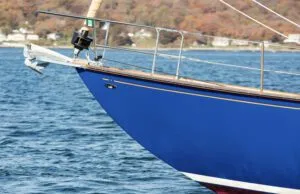
Due to increasing demand for these boats, prices have risen in some parts of the country and range from $70,000 for one in sound but fairly tired cosmetic condition to $140,000 for one that has been through a rehab that includes a new or nearly new engine, electrical system, tanks, refrigeration, rigging, sails, etc. In our online shopping, we found Pearson 41s ranging from $10,000 for a more-or-less gutted project boat, to $100,000 for a boat that was professionally restored to A standards. The bottom line is that these are modest-draft sailboats with lean, long overhangs and real sea berths, an easy motion, and enough functional space to qualify as a good inshore or offshore cruiser. They make excellent DIY candidates and continue to make their way to more than their fair share of distant landfalls.




